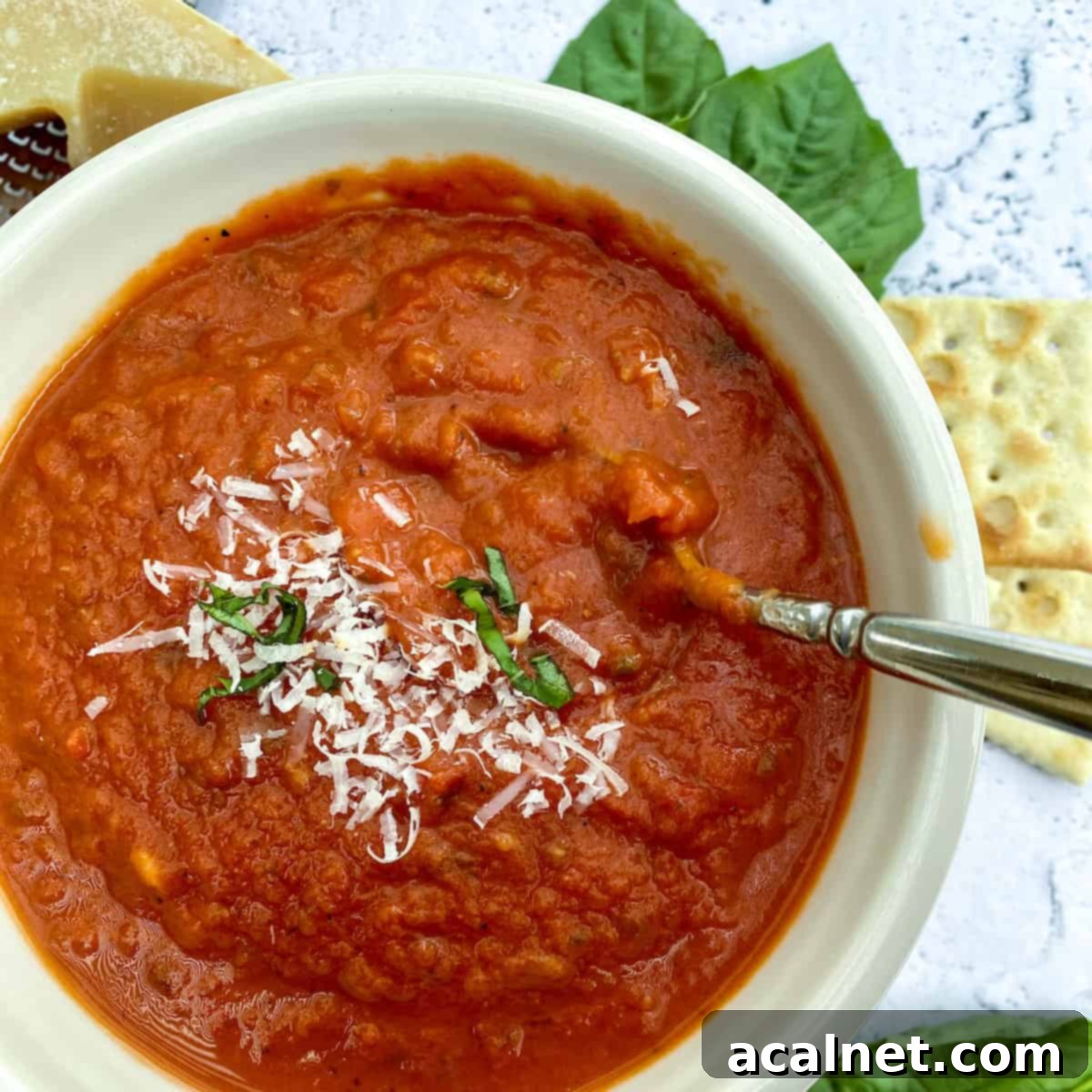Homemade Roasted Tomato Basil Soup: Your Ultimate Comfort Food Recipe
There’s nothing quite as comforting and profoundly satisfying as a warm bowl of homemade soup, especially when it’s bursting with fresh, vibrant flavors. Our Homemade Roasted Tomato Basil Soup is a true testament to this, offering a rich, thick, and incredibly flavorful experience that easily rivals any restaurant creation. The secret to its unparalleled depth and complexity? The magical transformation that occurs when farm-fresh (or even quality store-bought) tomatoes, aromatic garlic, and sweet onions are gently oven-roasted. This simple yet powerful technique brings out an incredible natural sweetness and an umami-rich complexity that raw or simply simmered ingredients just can’t match. Just like a hearty Crockpot Clam Chowder or a robust Beef Stew made lovingly from scratch, this recipe proves that a little extra effort yields truly extraordinary results. While any variety of fresh tomatoes will work beautifully, using Roma tomatoes is highly recommended for their meaty texture and lower water content, which naturally contributes to a wonderfully thick and rich soup without needing much thickener. Get ready to indulge in every single spoonful of this divine, soul-warming creation tonight – it’s a dish that promises to become a cherished family favorite!
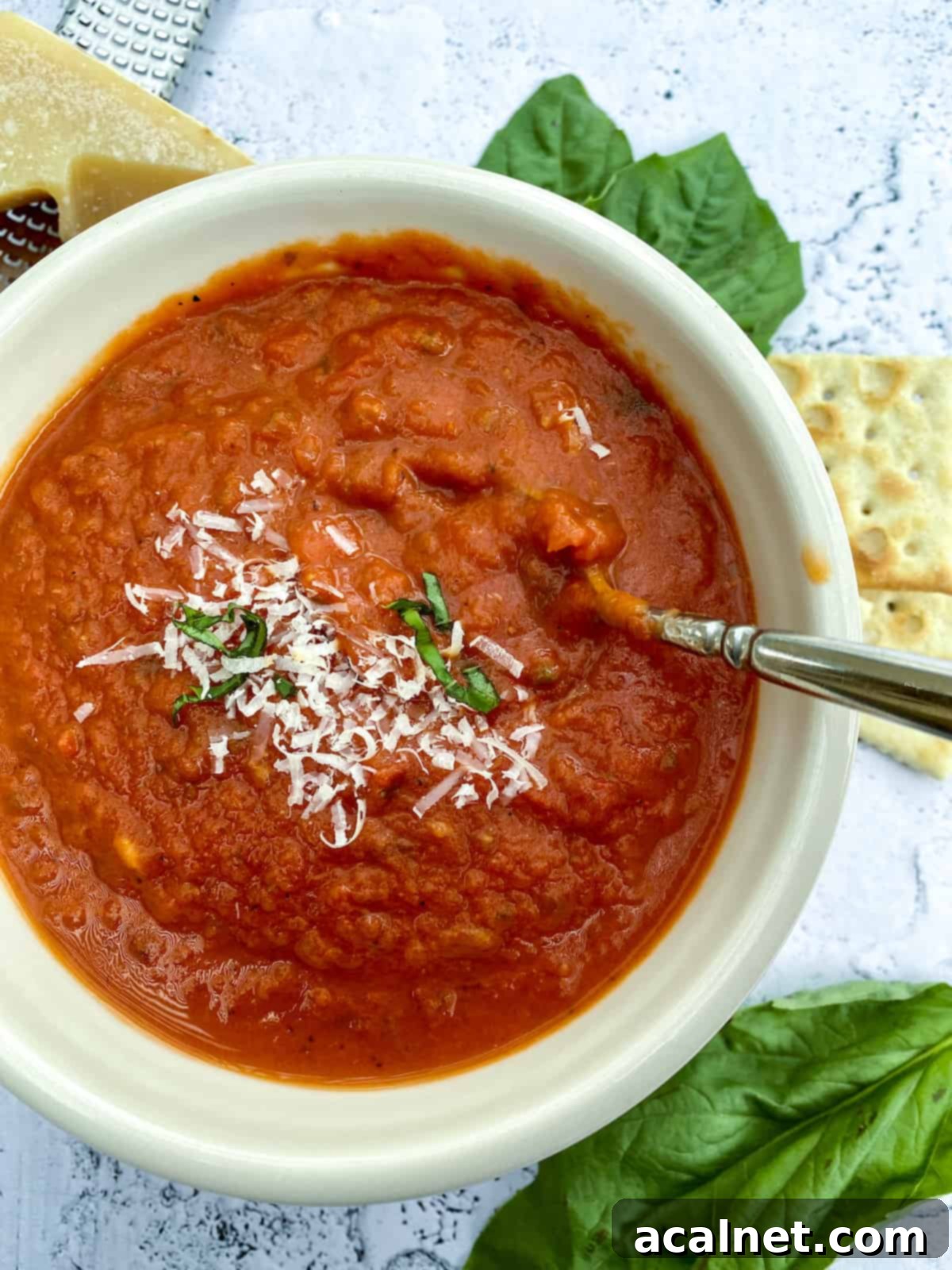
Eager to start cooking right away? Jump directly to the detailed Recipe Card!
Why Oven-Roasting is the Game-Changer for Your Tomato Soup’s Flavor
Many tomato soup recipes simply involve simmering fresh or canned tomatoes, which can yield a decent result. However, for a truly exceptional, deeply flavorful, and unforgettable tomato basil soup, oven-roasting is the game-changer you won’t want to skip. This process isn’t just about cooking; it’s about a magical culinary transformation that concentrates the natural sugars, caramelizes the edges of the vegetables, and develops an incredible depth of flavor that raw or simply boiled ingredients simply cannot achieve. When sweet Roma tomatoes, aromatic garlic, and pungent onions are slow-roasted at a high temperature, they undergo a wondrous change. They release their inherent sugars, intensifying their natural sweetness and creating a rich, complex, and savory foundation for your soup. The edges become beautifully tender, slightly charred, and wonderfully browned, adding a subtle smokiness and a nuanced layer of flavor that elevates the entire dish from good to absolutely gourmet. This seemingly simple step is, in fact, the most potent secret weapon behind our tomato basil soup’s unforgettable taste, guaranteeing a truly remarkable and satisfying experience right in your home kitchen. It’s the difference between ordinary and extraordinary.
Essential Ingredients for Crafting the Perfect Tomato Basil Soup
Crafting this incredible soup begins with selecting the right ingredients. Each component plays a vital and intentional role in building the robust, aromatic, and fresh flavor profile that makes this recipe so exceptional:
- Roma Tomatoes: These are our top recommendation for the fresh tomatoes used in this recipe. Their firm, meaty texture and relatively lower water content make them uniquely ideal for roasting. This results in a naturally thicker, richer soup base without introducing excessive liquid, ensuring concentrated flavor.
- Garlic: When subjected to the gentle heat of the oven, raw garlic cloves mellow beautifully. Their initially pungent and sharp bite transforms into a wonderfully sweet, nutty, and profoundly aromatic depth that subtly infuses the entire soup, creating a warm and inviting base.
- Onion: Roasting onions sweetens them considerably, coaxing out their inherent sugars and caramelizing them to create a delicate savory note. This provides a crucial foundational flavor layer that enhances the overall complexity of the soup.
- Olive Oil: A good quality extra virgin olive oil is essential for coating the vegetables before roasting. It not only aids in achieving that desirable caramelization but also contributes a smooth, Mediterranean undertone to the finished soup, tying all the flavors together.
- Crushed Tomatoes with Basil (Canned): To ensure a consistently rich and deeply tomatoey base, we use two 28-ounce cans of high-quality crushed tomatoes (we strongly recommend an organic brand like Muir Glen for their superior flavor and consistent texture). This also conveniently amplifies the basil notes from the start.
- Organic Vegetable Broth: A high-quality organic vegetable broth forms the essential liquid backbone of the soup. It adds savory complexity and a harmonious depth without overpowering the delicate fresh tomato and basil flavors, ensuring a well-balanced taste.
- Fresh Basil: This vibrant herb is unequivocally the star of the show! Fresh basil provides that unmistakable bright, slightly peppery, and sweet aroma that is the defining hallmark of this classic soup. For the best possible results, do not skimp on fresh basil.
- Cayenne Pepper: A subtle touch of cayenne pepper adds a gentle warmth and a mild, pleasant kick. This carefully balanced heat perfectly complements the sweetness of the roasted tomatoes and provides a nuanced layer of flavor. Adjust to your personal preference, or omit entirely for a milder soup.
- Heavy Whipping Cream: This is the luxurious finishing touch that transforms the soup into a velvety, indulgent creation. The cream adds unparalleled richness, a wonderfully smooth mouthfeel, and contributes to the soup’s beautiful pale orange hue.
- Salt, Pepper, and Sugar: These are crucial for seasoning and perfectly balancing the natural acidity of the tomatoes. The sugar acts as a counterbalance, bringing all the complex flavors into exquisite harmony and preventing the soup from tasting too tart.
For precise quantities and a complete, printable list of all ingredients, please refer to the detailed recipe card conveniently located at the very bottom of this article.
How to Oven Roast Your Vegetables for Unforgettable Tomato Basil Flavor
This is truly where the undeniable magic of this Homemade Roasted Tomato Basil Soup begins! The transformative power of oven-roasting is what elevates your soup from a simple, everyday dish to an absolutely extraordinary culinary experience. This surprisingly straightforward technique concentrates the natural sugars and intensifies the inherent flavors of your key ingredients in a profound way that mere simmering simply cannot achieve.
Begin by carefully preparing your fresh vegetables: precisely halve the Roma tomatoes lengthwise, slice the onion into thick, sturdy rings or uniform wedges, and peel the garlic cloves. You have the option to leave the garlic cloves whole; roasting will render them incredibly soft, sweet, and wonderfully easy to mash later. The crucial goal here is to maximize their surface area for optimal caramelization and browning.
Line a sturdy 13×9 inch (or similar size) baking sheet with parchment paper. This step is absolutely crucial, as it effectively prevents any sticking and ensures an incredibly easy cleanup process after roasting. Arrange the prepared tomatoes (cut side up or down, both methods yield excellent results), onion slices, and garlic cloves evenly across the parchment paper. It is paramount to ensure they are arranged in a single layer with enough space between them to roast effectively, rather than steaming, which would inhibit caramelization.
Drizzle a generous amount of high-quality olive oil evenly over all the vegetables. Then, gently toss them with your clean hands or a sturdy spatula to ensure every single piece is lightly and thoroughly coated. Finally, sprinkle them generously with a pinch of coarse sea salt and freshly cracked black pepper. This initial seasoning is vital for enhancing their natural flavors as they undergo the roasting process.
Place the prepared baking sheet into a preheated oven set at a robust 450° F (230° C). Allow them to roast for approximately 45-60 minutes. The exact roasting time may vary slightly depending on your specific oven’s calibration and the size and ripeness of your vegetables. You’ll know they’re perfectly roasted when the tomatoes have visibly softened, burst open, and started to beautifully blister. The onions should be tender and deeply caramelized with golden-brown edges, and the garlic should be fragrant, golden, and sweet to the touch. It’s advisable to keep a close eye on them towards the end of the roasting time to prevent any undesirable burning, especially for the smaller garlic cloves.
One of the most delightful and often unexpected aspects of preparing this soup at home is the absolutely incredible, intoxicating aroma that will lovingly waft and fill your entire kitchen as these vegetables slowly roast. It’s a deeply savory, slightly sweet, and intensely aromatic scent, instantly reminiscent of a bustling, authentic Italian trattoria or a cozy, rustic family meal. Nothing short of divine, this rich and comforting fragrance is your very first, tantalizing clue that something truly special, profoundly delicious, and soul-warming is coming together. This sensory experience alone makes the roasting step worth every moment.
Tomato Basil Soup vs. Bisque: Understanding the Delicious Distinction
The terms “soup” and “bisque” are frequently, and sometimes mistakenly, used interchangeably, especially when discussing creamy tomato-based dishes. However, there’s a subtle yet significant culinary distinction that can help you not only understand your creation better but also precisely customize it to your exact texture preference. Generally speaking, a bisque refers to a type of soup that is characterized by its exquisitely smooth, velvety texture, often achieved through pureeing, and the luxurious addition of cream. Historically, bisques were frequently seafood-based, such as lobster bisque, but over time, the term has broadly evolved to describe any pureed, inherently creamy, and richly flavored soup.
Therefore, if your homemade tomato basil creation is thoroughly blended until it achieves a silky-smooth consistency, completely devoid of any fibrous material or chunks, and you’ve incorporated heavy cream to enhance its richness, then you have, in essence, crafted a delicious and elegant Tomato Basil Bisque. The creamy mouthfeel, the homogenous texture, and the luxurious body are the defining characteristics here, offering a truly refined dining experience.
Conversely, if you prefer a heartier, more rustic mouthfeel and intentionally choose to leave small, tender chunks of the perfectly roasted tomato, fragrant fresh basil, or delicate onion in your mixture, then you have created a classic tomato basil soup. This approach provides a delightful textural contrast that many find equally appealing and comforting. Both preparations are undeniably delicious, comforting, and deeply flavorful, and the ultimate choice truly comes down to your personal preference for texture in your bowl.
Pro Tip for Ultimate Creaminess: Craving an extra-smooth, utterly restaurant-quality bisque experience? Achieving this luxurious texture is effortlessly simple! Just use your hand-held immersion blender for a few extra minutes, ensuring every last bit of vegetable and herb is completely pureed. This transforms your hearty soup into a perfectly smooth and luxurious Tomato Basil Bisque right in the pot, saving you extra dishes. It’s that easy to elevate your meal!
I’ve personally made and savored this recipe prepared both ways over the years, depending on my mood and what I’m serving it with. Some days, I genuinely appreciate the slight rustic chunkiness that offers a bit more bite and substance. Other times, I prefer it blended to absolute perfection, creating an extra smooth, incredibly creamy, and undeniably bisque-like version. The latter is especially divine when enjoyed alongside a perfectly crisp and gooey grilled cheese sandwich, creating the ultimate comfort food pairing that never fails to satisfy.
Essential Equipment for Crafting Your Homemade Tomato Basil Soup
Making this incredible, flavor-packed soup doesn’t demand a kitchen full of specialized gadgets or professional-grade equipment. However, a few key pieces of kitchen gear will significantly streamline the preparation process and ensure you achieve the best possible results with minimal effort. Having the right tools at hand makes achieving that desired velvety texture and rich, deeply infused flavor both easy and enjoyable, even for novice cooks.
An immersion blender, often referred to as a hand-held blender or stick blender, is an absolute game-changer and arguably the most crucial piece of equipment for this recipe. There’s simply no better or more convenient way to blend ingredients directly in a hot pot, which not only saves you from the tedious and potentially hazardous task of transferring hot liquids to a traditional stand blender but also reduces cleanup. An immersion blender allows you to precisely control the texture, effortlessly transforming your soup from a slightly chunky, rustic consistency to a perfectly silky-smooth bisque, all with minimal mess and maximum ease. If you don’t happen to own one, you can certainly use a regular countertop blender, but please be sure to work in small batches and exercise extreme caution when blending hot liquids. Never fill the blender jar more than halfway, and always vent the lid to allow steam to escape.
Beyond this versatile tool, the other essential items required are quite basic and likely already staples in your kitchen: a sturdy baking sheet for perfectly roasting your vegetables (a good quality, heavy-gauge sheet will ensure even browning and prevent warping), and a large stock pot. This generously sized pot will be where all your delicious, roasted vegetables and liquid ingredients come together to simmer gently, melding into the final, flavorful masterpiece. A heavy-bottomed stock pot is highly recommended, as it ensures even heating, prevents the soup from sticking to the bottom, and helps avoid scorching.
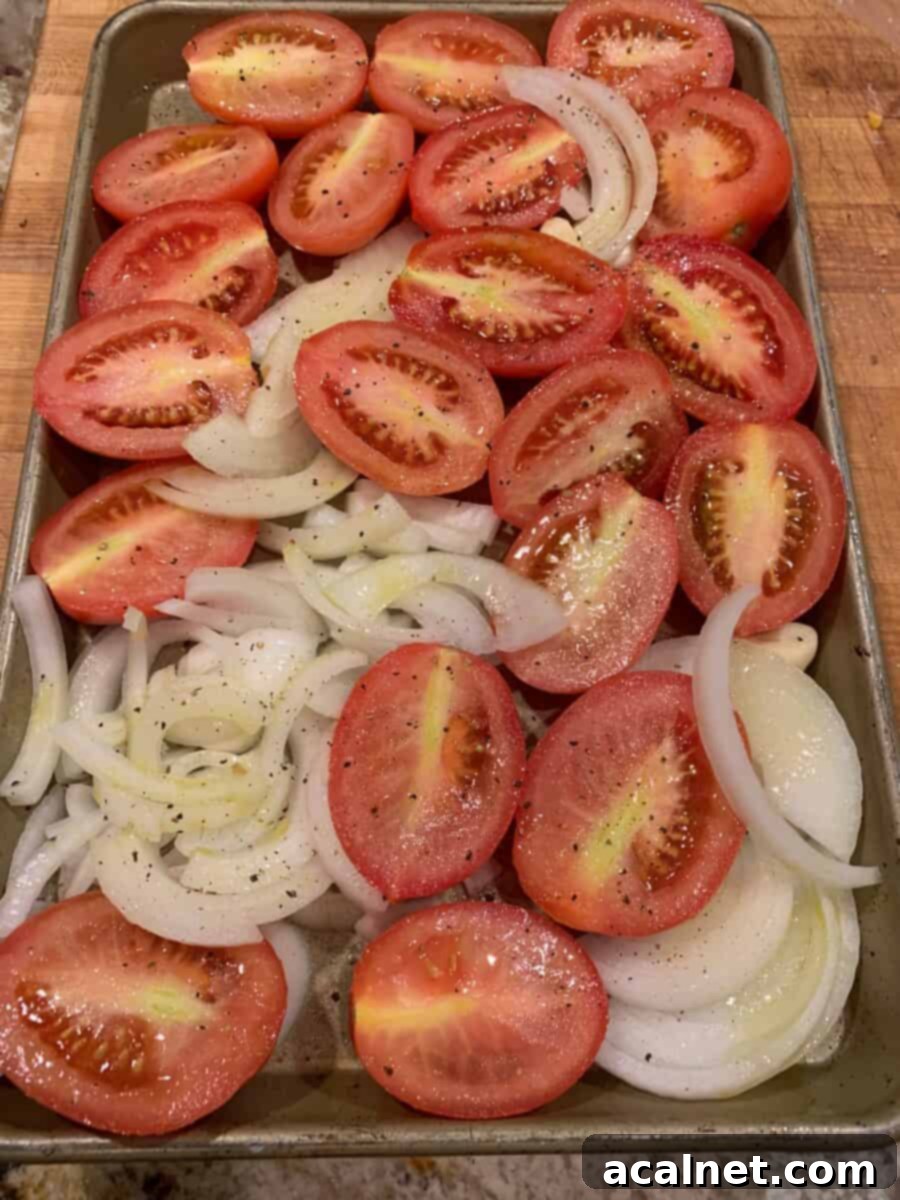
It’s a common misconception to think that preparing a soup from scratch, especially one that promises such rich and complex flavors, would be overly complicated, time-consuming, or require advanced culinary skills. However, this particular recipe triumphantly defies that notion! It’s surprisingly straightforward to prepare and consistently yields a deeply satisfying and undeniably gourmet result that far surpasses any store-bought or canned alternative you could ever find. The initial roasting step, while adding time, is largely hands-off, allowing you to prepare other components or simply relax while the oven does most of the heavy lifting. The payoff in profoundly enhanced flavor is immense and well worth the minimal effort.
If you genuinely appreciate the comforting warmth, the exquisite taste, and the unparalleled freshness of a truly homemade soup, then this Homemade Roasted Tomato Basil Soup recipe is an absolute must-try for your culinary repertoire. You’ll be astonished at how easily such an exquisite and comforting dish comes together, making it a perfect, impressive, yet simple addition to your regular meal rotation for family dinners or entertaining guests.
Bringing It All Together: Step-by-Step Stovetop Directions for Tomato Basil Soup
Once your wonderfully aromatic roasted tomatoes, tender caramelized onions, and sweet mellow garlic are perfectly prepared and out of the oven, the remaining steps for assembling this incredible soup on the stovetop are delightfully quick and incredibly simple. This is the crucial stage where all those rich, deeply developed flavors from the roasting process marry together to create a harmonious, comforting, and utterly delicious dish.
Carefully transfer all the roasted vegetables directly from the baking sheet into your large, heavy-bottomed stockpot. To these intensely flavorful vegetables, now add the two 28-ounce cans of high-quality crushed tomatoes with basil, the entire 32-ounce carton of organic vegetable broth, the roughly chopped fresh basil, 1 tablespoon of salt, 2 teaspoons of freshly ground black pepper, and the ¼ cup of sugar. The sugar is a critical ingredient here, as it effectively helps to balance the natural acidity of the tomatoes and profoundly enhances their inherent sweetness, ensuring a perfectly well-rounded and complex flavor profile. If you enjoy a little warmth and a gentle kick, now is also the ideal time to add the optional ⅛ teaspoon of cayenne pepper. Remember, hold off on the heavy whipping cream for now – that’s added right at the very end for ultimate creaminess and luxurious texture.
Now, it’s time to bring out your trusted immersion blender. Submerge the blender head into the pot, ensuring it’s fully covered by the ingredients, and begin to blend. Move the blender around slowly and deliberately, guiding it through all the vegetables and liquids until everything is thoroughly incorporated and reaches your desired consistency. You have complete control over the final texture at this stage. For a classic, slightly chunky tomato basil soup, blend until most large pieces are gone, but a delightful rustic texture remains. This often provides a satisfying and wholesome mouthfeel.
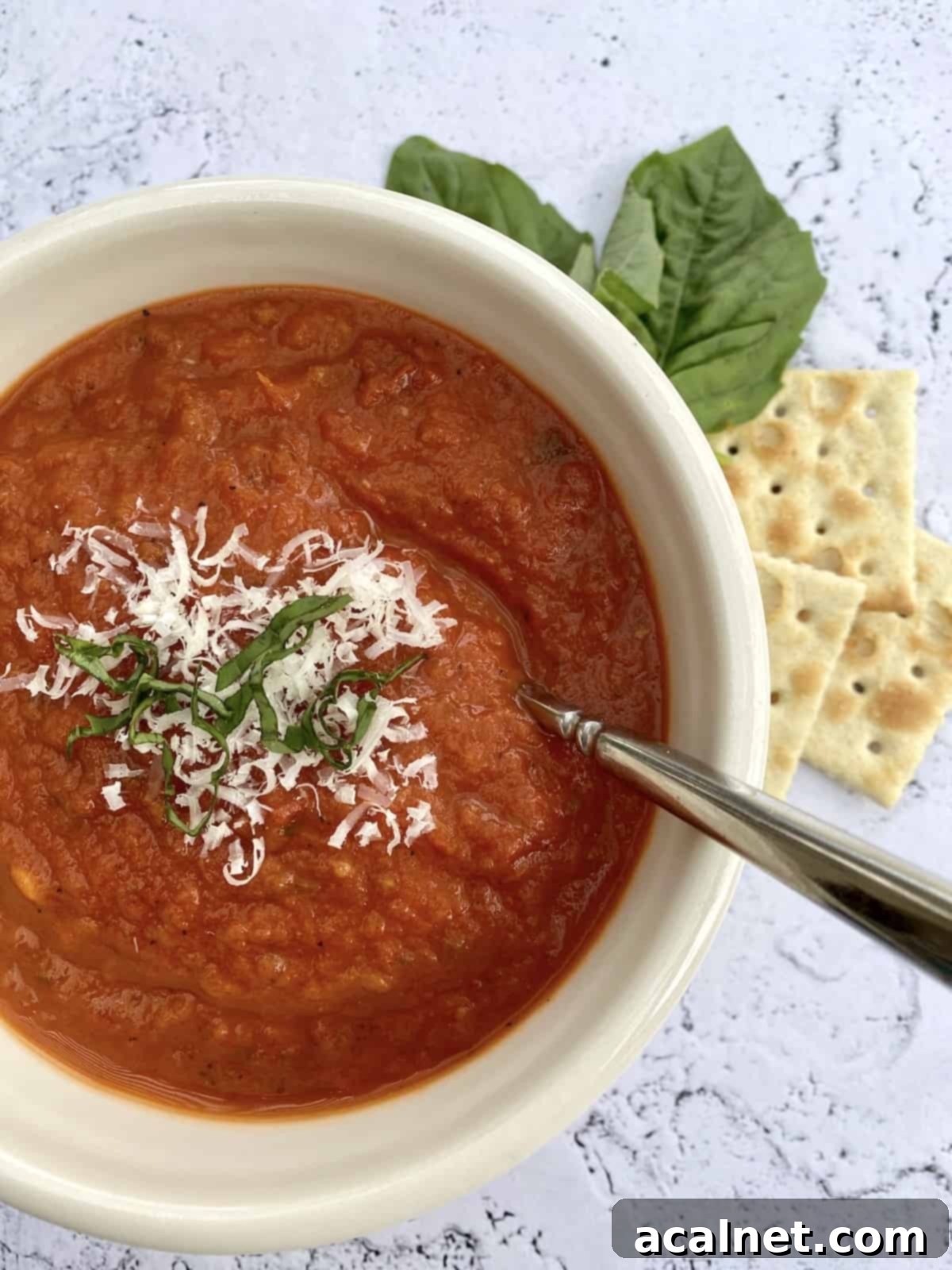
If, however, you desire a luscious, silky-smooth Tomato Basil Bisque, continue blending with the immersion blender until the soup reaches a uniform, velvety consistency with absolutely no discernible chunks or fibrous material. The longer and more thoroughly you blend, the smoother and more luxurious the soup will become. Once you’ve achieved your preferred texture, bring the soup to a low boil over medium heat, then immediately reduce the heat to a gentle simmer. Allow the flavors to meld and deepen for about 20-30 minutes, stirring occasionally to prevent any sticking to the bottom of the pot and to ensure even heating throughout.
Finally, remove the pot from the heat and gently stir in the ¼ cup of heavy whipping cream. It’s vitally important to heat the soup gently after adding the cream; carefully avoid bringing it back to a full boil, as this can sometimes cause the cream to curdle, altering the soup’s texture. Once warmed through and perfectly creamy, your Homemade Roasted Tomato Basil Soup is ready to serve! Garnish generously with extra fresh basil leaves, a delicate swirl of good quality olive oil, or a light sprinkle of freshly grated Parmesan cheese for an added touch of freshness and savory depth. Serve hot and savor every single comforting, flavorful spoonful.
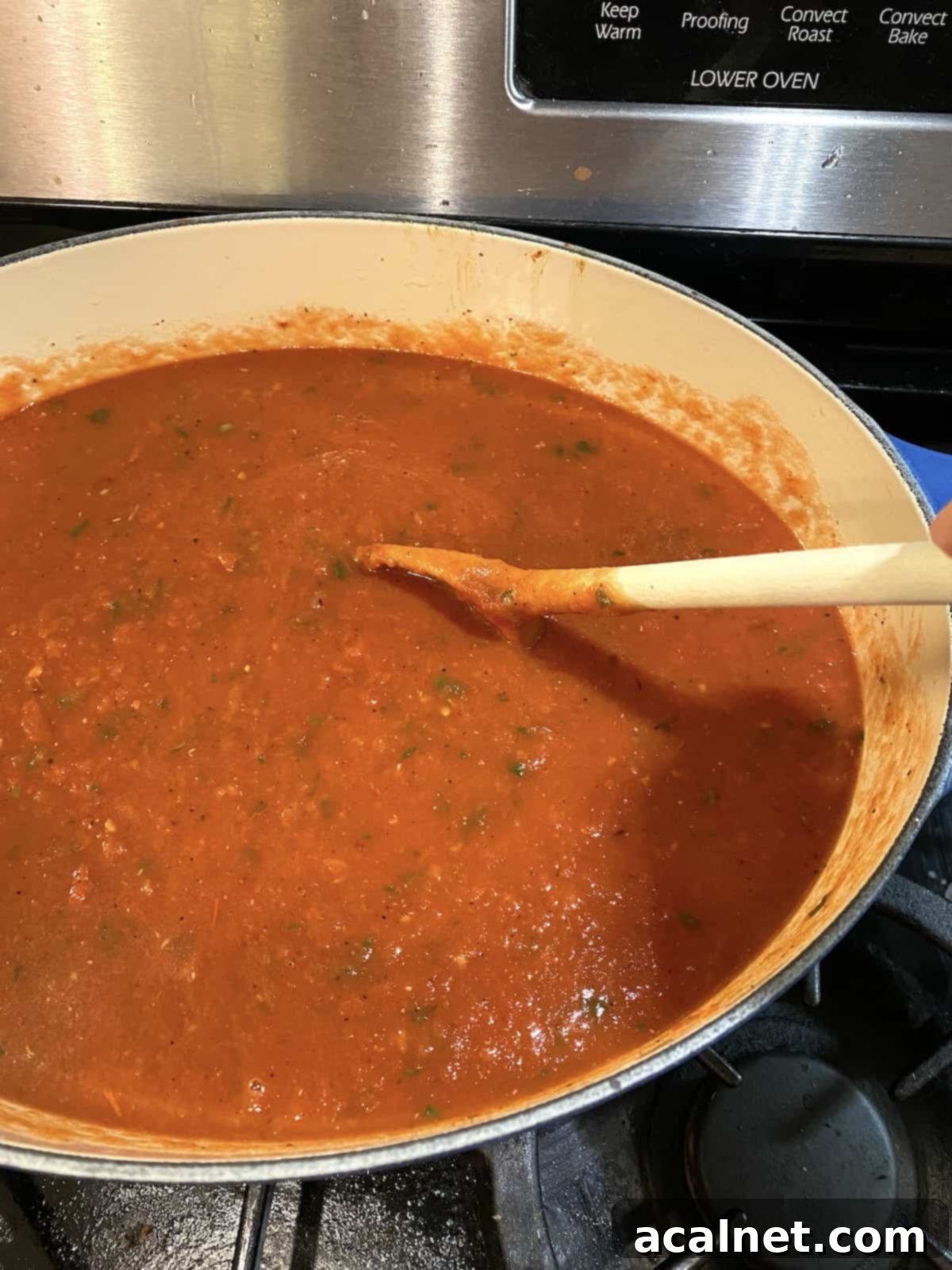
Top Tips and Frequently Asked Questions for Your Best Tomato Basil Soup
Absolutely! This homemade tomato basil soup is an excellent candidate for freezing, making it perfect for convenient meal prep, quick weeknight dinners, or saving for a cozy day. You’ll undoubtedly thank yourself for having a few quarts on hand in the freezer! To freeze properly, first allow the soup to cool completely to room temperature. Then, pour it into quart-sized, airtight, and freezer-safe containers or heavy-duty freezer bags. It’s crucial to leave at least an inch (about 2.5 cm) of headspace at the top of the container to allow for expansion as the soup freezes, which helps prevent containers from cracking. The soup will maintain its delicious quality in the freezer for up to 3-4 months. When you’re ready to enjoy it, simply thaw the soup overnight in the refrigerator, or gently reheat it directly from frozen on the stovetop over low heat, stirring frequently. You might need to add a splash of vegetable broth or water to thin it out if it becomes too thick after thawing.
That’s wonderful news! While this recipe specifically calls for canned crushed tomatoes to provide a consistent base and deep, robust flavor, you can certainly experiment with using exclusively fresh tomatoes beyond the initial roasted ones. My strong hunch is that it would yield an incredibly vibrant and intensely fresh-tasting soup. However, I haven’t personally tested it with an all-fresh tomato approach for the bulk of the recipe. If you choose to go this route, I highly recommend using a variety of ripe tomatoes for a more complex flavor profile – perhaps some juicy heirloom varieties for sweetness and tang, combined with more Roma tomatoes for a good body and texture. You’ll likely need to increase the total amount of fresh tomatoes used significantly (potentially 2-3 times the weight of the canned tomatoes) and possibly extend the roasting time or simmer time to achieve the desired concentration of flavor and thickness, as fresh tomatoes contain a much higher water content. If you try this, please do let me know your successful results in the comments section; I’d love to hear about it!
Adapting this rich and flavorful recipe for vegan or dairy-free diets is surprisingly easy and still results in a wonderfully creamy and satisfying soup! Simply ensure that the vegetable broth you’re using is clearly labeled as certified vegan. For the heavy whipping cream, you have a few excellent and readily available substitution options: a full-fat canned coconut milk (it’s crucial to use the thick, creamy kind from a can, not the thinner drinking coconut milk from a carton) works beautifully, adding a subtle sweetness and richness that complements the tomatoes without overpowering them. Alternatively, you can use an equal amount of your favorite unsweetened, unflavored dairy-free cream alternative, such as a cashew-based cream, oat cream, or even a rich soy cream. Just be sure to taste and adjust your seasonings after adding the substitute, as each alternative has its own unique flavor profile. Rest assured, the initial roasting process already provides so much incredible depth, you won’t even miss the dairy!
Tomato acidity can vary significantly depending on the ripeness, variety, and growing conditions of the tomatoes used. If your soup tastes a bit too sharp, acidic, or tangy, there are a few simple and highly effective tricks to balance the flavors and achieve perfect harmony. First, double-check that you added the ¼ cup of sugar as specified in the recipe – this is absolutely crucial for neutralizing acidity and enhancing the overall sweetness. If it still needs a boost, you can judiciously add another teaspoon or two of sugar, tasting carefully after each addition to ensure you don’t over-sweeten. A classic chef’s trick is to add a tiny pinch (approximately ¼ teaspoon) of baking soda; it will react with the acid and cause a slight fizzing reaction initially, but it’s incredibly effective at neutralizing excessive tartness. Alternatively, stirring in a bit more heavy cream (or your chosen dairy-free alternative) at the very end can also help mellow out the acidity and add a luxurious richness. Don’t be afraid to taste and adjust until it’s perfectly balanced for your personal palate!
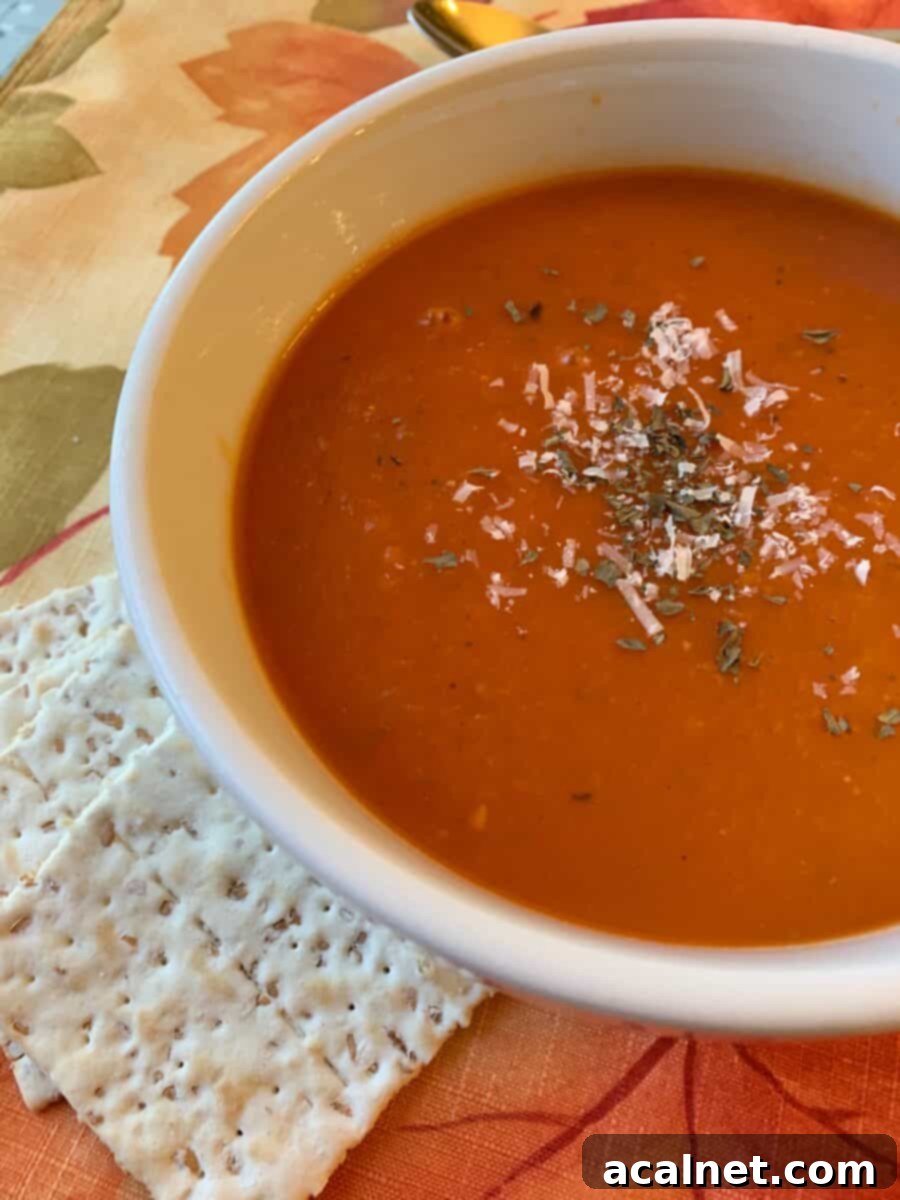
What to Serve with Your Homemade Tomato Basil Soup
Homemade Tomato Basil Soup is an incredibly versatile and deeply comforting dish that pairs beautifully with a wide array of accompaniments, transforming a simple meal into a delightful and satisfying dining experience. Whether you’re looking for a light and refreshing lunch, a satisfying appetizer, or a complete and hearty dinner, these thoughtful serving suggestions will undoubtedly elevate your meal:
- Classic Grilled Cheese Sandwich: This is arguably the most iconic, beloved, and universally adored pairing, and for very good reason! The creamy, warm, and slightly tangy soup is perfectly complemented by a gooey, golden, and perfectly crisp cheesy grilled sandwich. My family absolutely adores this timeless combination – it’s the quintessential comfort food duo, evoking nostalgic memories and pure satisfaction with every single bite.
- Crusty Bread or Garlic Bread: A warm, crusty baguette, a slice of artisanal sourdough, or savory homemade garlic bread is absolutely ideal for generously soaking up every last delicious drop of the flavorful soup. The delightful textural contrast between the soft, smooth soup and the crispy, chewy bread is wonderful, and garlic bread, in particular, adds an extra layer of aromatic deliciousness.
- Saltine Crackers: Simple yet incredibly satisfying, classic saltine crackers offer a beloved crunchy texture that many enjoy crumbling directly into their soup. They provide a nice salty counterpoint to the rich tomato flavor, adding an old-fashioned charm.
- Fresh Green Salad: For a lighter meal or to add a refreshing balance to the richness of the soup, a crisp, vibrant side salad is a fantastic choice. The bright flavors and crunchy textures of fresh greens offer a welcome contrast to the creamy and comforting soup. Some delicious and complementary side salad options to consider from our collection include:
- Pesto Pasta Salad with Peas
- Sweet Corn Pasta Salad
- Quick Pickled Cucumbers
- Spicy Black-Eyed Pea Salad
- Homemade Croutons or Toasted Seeds: For a delightful textural contrast and an extra layer of savory flavor, consider topping your soup with some crispy homemade croutons or a healthy sprinkle of toasted pumpkin or sunflower seeds. These add a wonderful crunch to each spoonful.
- A Dollop of Pesto or Swirl of Balsamic Glaze: For an extra gourmet touch and a burst of concentrated flavor, a small dollop of fresh basil pesto or a delicate swirl of sweet-tangy balsamic glaze can beautifully enhance the existing flavors, adding both visual appeal and a refined finish to your bowl.
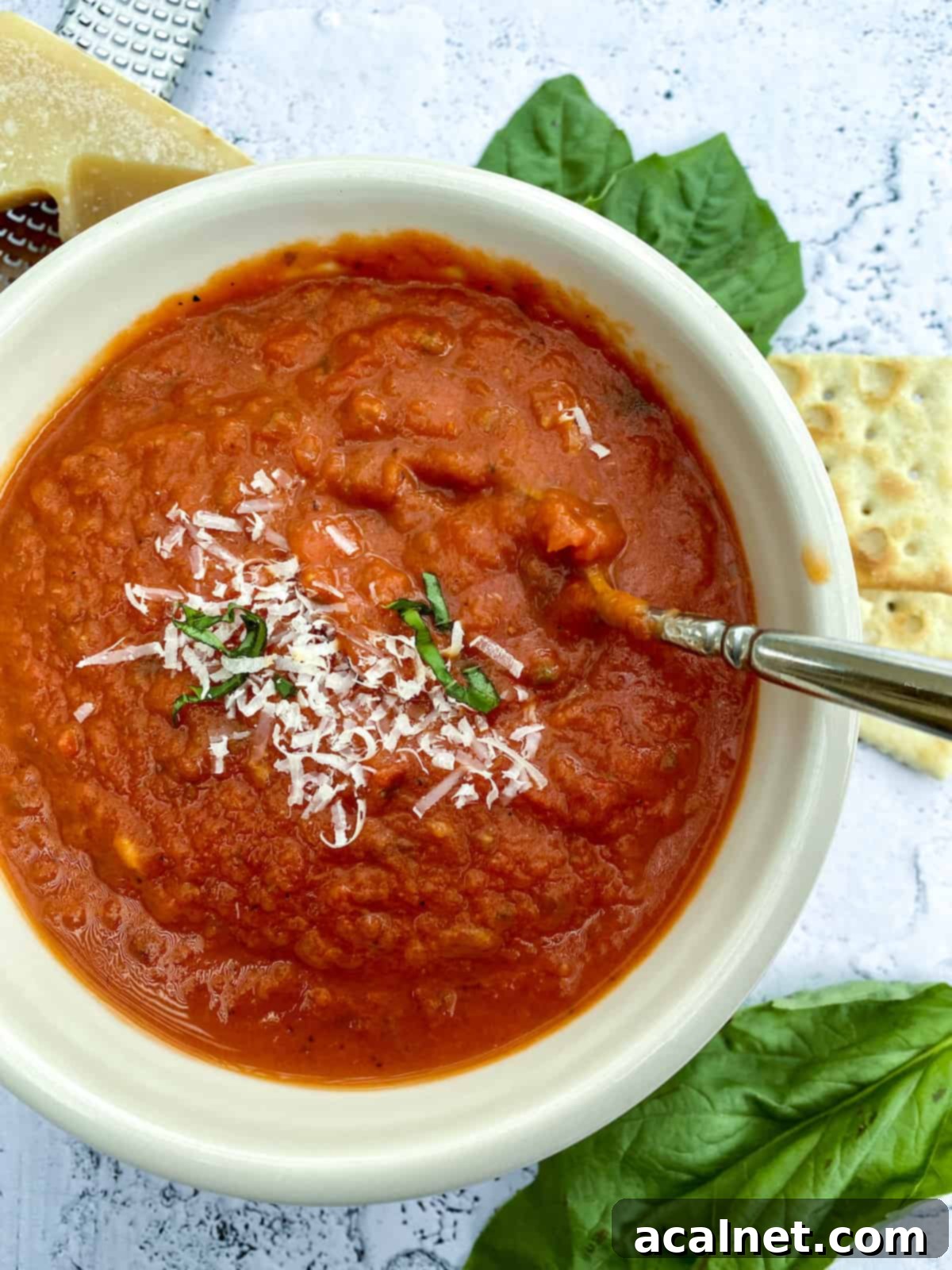
More Delicious Recipes Featuring the Versatile Tomato
Tomatoes are incredibly versatile and truly indispensable, forming the delicious heart of countless beloved dishes across various cuisines, whether they are fresh from the vine, perfectly ripe, or conveniently canned. Their vibrant, tangy, and sometimes subtly sweet flavor profile makes them an adaptable and essential centerpiece in many classic family-favorite recipes. If you love the robust and adaptable taste of tomatoes as much as we do, here are a few other highly popular recipes from my kitchen that consistently receive rave reviews and that you might thoroughly enjoy trying and adding to your meal rotation:
- Tomato-Cream Sauce: This simple yet elegantly rich sauce is your perfect go-to for creating a luscious homemade pasta topping any time you need a quick, flavorful, and comforting meal. It beautifully marries the bright tang of tomatoes with a luxurious creaminess, making it an instant classic for weeknight dinners that feels gourmet.
- Baked Beef Burritos: This is a highly requested recipe that my family asks for time and time again! It features a savory and hearty filling where canned tomatoes are wonderfully spiced up with a homemade mix, perfectly complemented by the healthy inclusion of fresh spinach and wholesome black beans. This recipe is undeniably a keeper, offering robust, filling, and truly satisfying flavors.
- Idaho Chili: A truly hearty, warming, and deeply satisfying chili recipe that calls for a generous amount of diced tomatoes and rich tomato sauce. My particular recipe also includes flavorful beans for added texture, protein, and a wonderful depth of flavor, ensuring it’s a consistently delicious and comforting bowl every single time you prepare it, perfect for chilly evenings.
If you’ve made and genuinely enjoyed this Homemade Roasted Tomato Basil Soup or any other delightful recipe from my website, I would be incredibly grateful if you could take a moment to leave a 🌟 star rating and share your valuable experience and thoughtful comments in the 📝 comments section below. Your feedback truly helps me and means a lot to our community!
Recipe Card
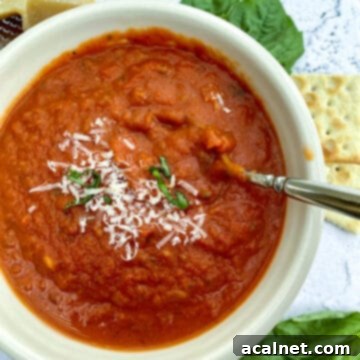
Homemade Roasted Tomato Basil Soup
Print
Rate
Pin Recipe
Ingredients
- 10 Roma tomatoes – cut in half
- 5 garlic cloves – about two tablespoons of chopped garlic
- 1 onion – sliced
- 2 tablespoons olive oil
- salt and pepper to taste – or about ½ teaspoon each
- 2, 28 ounce cans crushed tomatoes with basil – I use Muir Glen organic brand
- 1, 32 ounce carton of organic vegetable broth
- 1 cup fresh basil – roughly chopped
- 1 tablespoon salt
- 2 teaspoons pepper
- ¼ cup sugar
- ⅛ teaspoon cayenne pepper – to taste, or leave it out because this adds noticeable “kick” to your soup
- ¼ cup heavy whipping cream
- Dried or fresh, sliced basil and grated parmesan cheese for garnish – optional
Instructions
- Preheat your oven to 450° F (230° C). This high temperature is key for optimal caramelization.
Oven-Roast Tomatoes, Onion and Garlic
- Spray a 13 x 9 inch baking sheet with non-stick cooking spray, or for easier cleanup, line the pan with parchment paper.
Arrange the halved Roma tomatoes, peeled garlic cloves, and sliced onions evenly on the prepared baking sheet. Drizzle and brush thoroughly with 2 tablespoons of olive oil, ensuring all vegetables are lightly coated. Season lightly with salt and freshly ground black pepper.
Bake for 45-60 minutes in the preheated oven, or until the vegetables are beautifully roasted, tender, sizzling, and the tomatoes have started to blister and slightly caramelize around the edges. (Note: Cooking time may be slightly shorter or longer if you use a different variety or size of tomatoes. Your kitchen will smell absolutely divine during this step!)
Blend Ingredients and Simmer
- Carefully transfer all the roasted vegetables into a large stock pot. Add the two cans of crushed tomatoes with basil, the organic vegetable broth, the fresh basil, 1 tablespoon salt, 2 teaspoons pepper, ¼ cup sugar, and ⅛ teaspoon cayenne pepper (if you prefer a slight kick).
Using an immersion blender, submerge the head into the pot and blend all ingredients directly until you achieve your desired texture – from a rustic, slightly chunky soup to a perfectly smooth and creamy bisque.
Bring the soup to a low boil over medium heat, then reduce the heat to low and allow it to gently simmer for 20-30 minutes. This simmering time allows the flavors to fully meld and deepen beautifully.
- Remove the pot from the heat and gently stir in the ¼ cup heavy whipping cream. Heat the soup gently until warmed through; it is important not to boil the soup after adding the cream, as this can cause it to curdle.
Serve hot, garnished with dried or fresh basil and freshly grated Parmesan cheese, if desired. This Homemade Roasted Tomato Basil Soup is exquisitely delicious when served with crispy crackers, warm crusty bread, or classic grilled cheese sandwiches. Enjoy every comforting spoonful!
Notes
Please note: The nutrition details provided are estimated using a food database and should be considered a rough estimate, not exact scientific figures. Nutritional values can vary based on specific ingredients and preparation methods.
